
MProBat
18-12-2017
Proiettore ricaricabile - batteria al piombo
ISTRUZIONI PER L’USO E ISTRUZIONI DI SICUREZZA
Istruzioni originali
Projector rechargeable - Lead Acid Battery
INSTRUCTION MANUAL AND SAFETY INSTRUCTIONS
Translation of the original instructions
ATTENZIONE! Prima di usare l’apparecchio, leggete attentamente le istruzioni per l’uso
CAUTION! Before starting the appliance, read the operating instructions carefully

- 2 -
i
AVVERTENZE DI SICUREZZA
ATTENZIONE! Leggere tutte le avvertenze e
tutte le istruzioni.
La mancata ottemperanza alle avvertenze e alle
istruzioni può dare luogo a scosse elettriche,
incendi e/o lesioni serie.
Utilizzate l’apparecchio solo nei modi descritti
in queste istruzioni. Non utilizzatelo per scopi
a cui non è destinato.
Conservare tutte le avvertenze e le istruzioni
per riferimenti futuri.
a) Non puntare il fascio luminoso contro le
persone o gli animali. Una luce intensa può
danneggiare la vista.
b) Non puntare il fascio luminoso contro i
veicoli. Abbagliare il conducente può creare
un incidente.
c) Non utilizzate la torcia per immersioni
subacque. Immergere la torcia nell’acqua la
danneggia in modo irreparabile.
d) Non toccare lo schermo di protezione per-
ché può raggiungere temperature elevate.
e) Tenere i bambini e i passanti a distanza
durante il funzionamento di un apparecchio
elettrico. Prevenite possibili incidenti.
f) Non far funzionare utensili elettrici in atmo-
sfere esplosive o infiammabili, ad esempio
in presenza di liquidi, gas o polveri. Gli
apparecchi elettrici creano scintille.
g) Mantenete in un luogo sicuro i sacchi di
nylon presenti nell’imballaggio. I sacchi
possono provocare il soffocamento e i bambini
non devono entrarne in possesso.
h) Utilizzare un’alimentazione elettrica pro-
tetta da un interruttore differenziale (RCD).
L’utilizzo di un interruttore differenziale riduce il
rischio di scossa elettrica; consultate il vostro
elettricista di fiducia.
i) Non esporre l’apparecchio a batteria al calore
o al fuoco. Non esporre alla luce solare diretta.
Non lasciarlo all’interno di veicoli o cassette
attrezzi esposti al sole. Pericolo di esplosione.
j) Una batteria usata impropriamente può
provocare la fuoriuscita di vapori. Arieggiare
il locale e consultare un medico in caso di
necessità.
k) Mettere le batterie e gli apparecchi elettrici
fuori dalla portata dei bambini. E’ buona
norma mantenere i bambini lontano dalle
apparecchiature elettriche.
l) Utilizzare il caricabatterie in ambienti chiusi
al riparo dalla pioggia e dall’umidità. Preve-
nite possibili folgorazioni elettriche.
m) Ricaricare soltanto con il caricabatterie
specificato dal costruttore. Un caricabatterie
che è adeguato per un tipo di batterie può
creare un rischio di incendio quando viene
utilizzato con altri tipi di batterie.
n) La tensione di alimentazione del caricabat-
terie deve corrispondere a quella dichiarata
sulla targa dati dello stesso. Non utilizzate
nessun altro tipo di alimentazione.
o) Mantenete il caricabatterie sempre pulito.
Polvere e sporcizia impediscono il corretto
funzionamento.
p) Prima di ogni impiego controllare il carica-
batterie, il cavo e la spina. Non utilizzateli in
caso di danni o guasti.
q) Verificate periodicamente il cavo di alimen-
tazione elettrica. Non schiacciate o calpe-
state il cavo di alimentazione elettrica. Un
cavo danneggiato è fonte di scosse elettriche.
r) Non usurare il cavo. Non utilizzare mai il
cavo per trasportare, tirare o scollegare
dalla presa di alimentazione. Tenere il cavo
lontano da calore, olio, bordi affilati o parti
in movimento. Cavi danneggiati o attorcigliati
aumentano il rischio di scossa elettrica.
s) Non utilizzare il caricabatterie e non ap-
poggiare l’apparecchio su basi facilmente
infiammabili (come carta, tessuti, legno
ecc.). Con apparecchio acceso mantenete
almeno 1 metro di distanza da tendaggi, mo-
bilio ecc. Prevenite possibili incendi a seguito
di surriscaldamenti.
t) Ricaricate l’apparecchio con temperatura
ambiente compresa tra 10°C e 35°C. Tempe-
rature inferiori o superiori possono danneggiare
la batteria e non permettere la normale ricarica.
u) Scollegate il caricabatterie dalla rete rete
elettrica quando non lo usate. Non lasciate
il caricabatterie acceso con l’apparecchio
completamente carico. Non utilizzare l’ap-
parecchio durante la fase di carica. Prevenite
possibili incidenti.
v) È normale che il caricabatterie e la batteria
si riscaldino durante la fase di carica. E’ però
necessario lasciarli raffreddare entrambi,
fino a temperatura ambiente, tra due ricari-
che consecutive. Temperature elevate posso-
no provocare guasti o esplosione della batteria.
w) Sostituite l’apparecchio che ha terminato
il suo ciclo di utilizzo. Se la batteria si scarica
molto velocemente e/o i cicli di ricarica sono

- 3 -
molto corti è segnale che il suo ciclo di utilizzo
è terminato.
x) Utilizzate esclusivamente batterie di ri-
cambio originali (se sostituibili), del tipo e
con caratteristiche uguali a quella fornita
con l’apparecchio. L’uso di batterie di tipo o
con voltaggio diverso possono danneggiare
l’apparecchio e generare pericoli. Acquistate
esclusivamente ricambi originali.
y) Non usare l’apparecchio se l’interruttore
di accensione/spegnimento non si aziona
correttamente. Qualsiasi apparecchio elettrico
che non può essere controllato con l’interrut-
tore è pericoloso e deve essere sottoposto a
riparazioni.
z) Fare effettuare le operazioni di manuten-
zione solo da personale tecnico qualificato
che utilizza soltanto ricambi originali. Questo
permetterà di mantenere la sicurezza dell’ap-
parecchio elettrico.
aa) Non tentare di riparare l’apparecchio
elettrico o di accedere ad organi interni.
Interventi effettuati da personale non qualificato
e non autorizzato dalla Ditta costruttrice può
generare seri pericoli ed annulla la garanzia.
ab) Richiedete solo ricambi originali. L’utilizzo
di ricambi non originali può compromettere la
sicurezza dell’apparecchio elettrico.
ac) In caso di dubbio in campo elettrico affida-
tevi ad tecnico specializzato di comprovata
esperienza. L’utilizzo dell’elettricità in modo
non sicuro è molto pericoloso per la vostra ed
altrui incolumità.
AVVERTENZE DI SICUREZZA PER L’ADATTA-
TORE ALLA PRESA ACCENDISIGARI
a) Consultate le istruzioni fornite a corredo
del veicolo per il collegamento alla presa
accendisigari.
b) Non caricare l’apparecchio all’interno del
veicolo ma solo all’esterno, in una zona
protetta dalla pioggia, dall’umidità e dalla
polvere.
c) L’operazione di caricare la batteria dell’ap-
parecchio potrebbe scaricare la batteria
del veicolo e di conseguenza non poter più
avviare il veicolo.
Vi ringraziamo per averci preferito nella scelta
di questo apparecchio elettrico, di seguito chia-
mato “proiettore alogeno a batteria ricaricabile”.
Questo istruzioni riportano le informazioni e
quanto ritenuto necessario per il buon uso, la
conoscenza e la normale manutenzione.
COMPONENTI
Fare riferimento alla fig. A
1 Interruttore acceso/spento
2 Impugnatura
3 Pulsante per sblocco impugnatura (se presente)
4 Appoggio regolabile
5 Schermo di protezione
6 Presa di ricarica
7 Caricabatteria
8 Spina di alimentazione
9 Spinotto di ricarica
10 Adattatore di ricarica per presa accendisigari
(se presente)
11 Cinghia tracolla (se presente)
12 Sorgente luminosa
SIMBOLOGIA
Osservate con attenzione la simbologia e memo-
rizzate il rispettivo significato. Una corretta inter-
pretazione dei simboli consente un uso più sicuro.
Modello, dati tecnici e lotto di fabbrica-
zione. Le prime 2 cifre del lotto indicano
l’anno di fabbricazione.
Attenzione!
Leggete con attenzione tutte le istruzioni
prima dell’uso
Doppio isolamento elettrico
Solo per uso interno e in ambienti asciutti
Fusibile
Trasformatore d’isolamento
I rifiuti elettrici ed elettronici possono con-
tenere sostanze pericolose per l’ambiente e per
la salute umana; non devono pertanto essere
smaltiti con quelli domestici ma mediante una
raccolta separata negli appositi centri di raccolta
o riconsegnati al venditore nel caso di acquisto di

- 4 -
una apparecchiatura nuova analoga. Lo smalti-
mento abusivo dei rifiuti comporta l’applicazione
di sanzioni amministrative.
Smaltimento batterie. Le batterie incluse
nell’apparecchio possono essere smaltite assie-
me ad esso ma devono seguire una procedura
separata. Non gettate nel fuoco e non disperdete
nell’ambiente le batterie esauste ma consegna-
tele agli appositi centri per il loro smaltimento.
Non smaltire assieme ai rifiuti domestici
V Volt
Hz Hertz
~ corrente alternata AC
corrente continua DC
A Ampere
W Watt
h ore
°C gradi centigradi
Pb piombo
ON acceso
OFF spento
+ polo positivo
- polo negativo
ISTRUZIONI D’USO
CARICA DELLA BATTERIA DEL PROIETTORE
ATTENZIONE! Prima di utilizzare il proietto-
re è necessario effettuare una carica completa
della batteria.
La batteria interna può essere caricata mediante
il caricabatterie da collegare ad una presa elettri-
ca 230V~50Hz, oppure tramite l’adattatore da
collegare ad una presa accendisigari in corrente
continua 12V di un veicolo.
1. Assicuratevi che il proiettore sia spento
O - OFF.
2. Inserite lo spinotto (pos.9) presa di ricarica
(pos.6).
3. Inserite la spina di alimentazione del carica-
batterie (pos.8) nella presa di alimentazione.
4. La durata di una carica completa è indicata
nei dati tecnici. Non lasciare in carica oltre il
tempo necessario. A carica ultimata staccate
il caricabatterie dall’alimentazione elettrica e
sganciate lo spinotto.
Per mantenere efficiente la batteria:
- mantenere la batteria sempre carica
- ricaricare ogni 3 mesi, anche in caso di inutilizzo
- non lasciare la batteria scarica
- effettuate una ricarica se notate un calo
evidente delle prestazioni luminose.
Rammentate sempre che la batteria si usura e
dopo un certo periodo termina il suo ciclo di fun-
zionamento. I fattori che influiscono sulla durata
sono: numero dei cicli di carica/scarica, stress da
utilizzo gravoso, tempo dalla sua fabbricazione,
assenza di manutenzione, assenza di carica.
Attenzione! E’ vietato l’utilizzo diretto con fonti
di alimentazione esterne (es. un alimentatore).
Il funzionamento diretto mediante un alimen-
tatore danneggia il proiettore.
ACCENSIONE E SPEGNIMENTO
Premere l’interruttore (pos.1) per accendere
“I – ON” o spegnere “O - OFF”.
USO DEL PROIETTORE
Afferratelo saldamente sull’impugnatura ed
accendetelo azionando l’interruttore, sempre
con fascio rivolto verso il basso, mai verso i
vostri occhi.
La cinghia a tracolla (se presente) deve essere
fissata ai 2 anelli presenti nel proiettore.
Il fascio luminoso produce calore: non toccare
lo schermo protettivo (pos.5), non avvicinatelo e
non appoggiarlo a cose/superfici facilmente in-
fiammabili (vestiti, tendaggi, carta, mobilio ecc.).
Una caduta a terra dell’apparecchio potrebbe
danneggiarlo in modo irreparabile; fate attenzione
perché questo guasto non è coperto da garanzia.
Spegnete l’apparecchio se non la utilizzate.
Non lasciate l’apparecchio in mano ai bambini,
non è un giocattolo! L’utilizzo deve essere fatto
con responsabilità per evitare problemi alla vista
o incidenti.
MANUTENZIONE
ATTENZIONE! Prima di ogni controllo
staccate l’alimentazione elettrica del cari-
cabatterie scollegando la spina dalla presa.
ATTENZIONE! Non manomettete o tentate
di riparare il proiettore o il caricabatterie.
Pulite regolarmente ed abbiate cura del vostro
apparecchio elettrico, vi garantirete una perfetta
efficienza ed una lunga durata dello stesso.
- Rimuovete la polvere con uno straccio morbido.
- Lo schermo di protezione deve essere pulito
solo con un panno apposito per evitare rigatu-
re. Attendete che lo schermo si sia raffreddato
prima di procedere alla sua pulizia.

- 5 -
- Non spruzzate o bagnate d’acqua l’apparecchio
e il caricabatterie, pericolo di infiltrazioni interne.
- Non usate infiammabili, detergenti o solventi
vari. Le parti in plastica sono aggredibili da
agenti chimici.
Sostituzione lampadina (se esistente)
DA NON CONSIDERARE PER MODELLI A LED
Prima di procedere osservate attentamente i
componenti dell’apparecchio e la fig.C. Se non
avete dimestichezza con la manipolazione e
l’assemblaggio di componenti meccanici/elet-
trici, vi consigliamo di rivolgervi ad un centro
assistenza autorizzato.
Le lampadine alogene devono essere maneggia-
te toccando esclusivamente la parte inferiore e
comunque evitando che le dita entrino in contatto
con il bulbo in vetro. Un eventuale contatto con
il bulbo in vetro può ridurre l’efficienza della
lampadina e la sua durata. In caso di contatto
accidentale delle dita con il bulbo, si raccoman-
da di pulire la parte interessata con un panno
imbevuto di alcool e di lasciarla asciugare bene
prima del montaggio.
1. Spegnete il proiettore ‘O - OFF’
2. Svitate la ghiera dello schermo di protezione;
se è presente una vite/i sull’esterno ghiera
è necessario prima svitarla completamente
3. Estraete senza forzare la parabola porta-
lampada dalla scocca del proiettore; fare
attenzione che è fragile e non tiratela ecces-
sivamente per non strappare i cavi interni di
collegamento
4. Scollegate il cavo della lampadina sgancian-
do il faston, sollevate la molla ed estraete il
portalampada contenente la lampadina
5. Inserite la nuova lampadina afferrandola nel
portalampada e non nel bulbo, riposizionate
la molla in modo da bloccare la lampadina
e collegate il cavo innestando il faston; se è
presente una guaina e necessario riposi-
zionarla in modo da coprire completamente
i contatti metallici del cavo
6. Riposizionate la parabola portalampada
facendo aderire bene la sua guarnizione alla
scocca circolare del proiettore
7. Avvitate la ghiera a fondo senza forzare e
riavvitate la vite/i (se presente)
8. Premete l’interruttore per verificare il corretto
funzionamento dell’apparecchio.
Sostituzione batteria
Rivolgetevi ad un centro assistenza autorizzato.
PROBLEMI, CAUSE E RIMEDI
PROBLEMA CAUSE RIMEDI
Il proiettore
non si accende
Interruttore non
premuto
Premere l’interrut-
tore
Sorgente lumi-
nosa
Sostituire la lam-
padina, o, in caso
di fonte luminosa
LED, rivolgersi ad
un CentroAssi-
stenza
Batteria scarica Effettuare una rica-
rica completa
Guasto elettrico Rivolgetevi ad un
centro di assistenza
autorizzato
La batteria non
si ricarica
Spinotto di rica-
rica non inserito
correttamente
Sganciate lo spi-
notto e inserite a
fondo
Caricabatterie
non pronto per
la ricarica
Inserire la spina nel-
la presa di alimen-
tazione elettrica
Per adattatore ac-
cendisigari: il fu-
sibile a bordo del
veicolo è guasto
ed ha interrotto
l’alimentazione
Controllare i fusibili
del veicolo e sosti-
tuire quelli guasti
Caricabatterie
guasto
Rivolgetevi ad un
centro di assisten-
za autorizzato
Batteria guasta Rivolgetevi ad un
centro di assisten-
za autorizzato
ATTENZIONE! Se dopo aver eseguito gli
interventi sopra descritti l’apparecchio elet-
trico non funziona correttamente o in caso di
anomalie diverse da quelle indicate, portatelo
presso un centro di assistenza autorizzato
esibendo la prova di acquisto. Fate sempre
riferimento alle informazioni riportate sull’e-
tichetta dati tecnici.
IMMAGAZZINAMENTO
Effettuate una accurata pulizia dell’apparecchio
(vedi paragrafo Manutenzione) ed utilizzate
l’imballo originale per proteggerlo.
Se prevedete di non usare l’apparecchio per un
lungo periodo, effettuate una ricarica completa
della batteria.
Riponete l’apparecchio lontano dalla portata dei
bambini, in posizione stabile e sicura. Il luogo

- 6 -
dovrà essere asciutto, privo da polveri, tempe-
rato e protetto dai raggi solari diretti.
SMALTIMENTO
Per la salvaguardia ambientale procedete se-
condo le leggi vigenti del Paese in cui vi trovate.
Rivolgetevi alle autorità competenti per maggiori
notizie in merito.
Quando non è più utilizzabile né riparabile, con-
segnate l’apparecchio con l’imballo ad un punto
di raccolta per il riciclaggio.
Smaltimento batterie. Le batterie incluse
nell’apparecchio possono essere smaltite assie-
me ad esso ma devono seguire una procedura
separata. Non gettate nel fuoco e non disperdete
nell’ambiente le batterie esauste ma consegna-
tele agli appositi centri per il loro smaltimento.
Non smaltire assieme ai rifiuti domestici.
I rifiuti elettrici ed elettronici possono con-
tenere sostanze pericolose per l’ambiente e
la salute umana; non devono pertanto essere
smaltiti con quelli domestici ma mediante una
raccolta separata negli appositi centri di raccolta
o riconsegnati al venditore nel caso di acquisto di
una apparecchiatura nuova analoga. Lo smalti-
mento abusivo dei rifiuti comporta l’applicazione
di sanzioni amministrative.
GARANZIA
Il prodotto è tutelato a norma di legge contro non
conformità rispetto alle caratteristiche dichiarate
purché sia stato utilizzato esclusivamente nel
modo descritto dalle istruzioni, non sia stato
manomesso in alcun modo, sia stato conser-
vato correttamente, sia stato riparato da tecnici
autorizzati e, ove previsto, siano stati utilizzati
solo ricambi originali.
In caso di utilizzo industriale o professionale
oppure in caso di impiego simile la garanzia ha
validità di 12 mesi.
Per emettere una richiesta di intervento in garan-
zia è necessario presentare la prova di acquisto
al rivenditore o ad centro assistenza autorizzato.

- 7 -
g
SAFETY WARNINGS
WARNING! Read all warnings and all instructions.
Failure to follow warnings and instructions
may result in electric shock, fire and/or se-
rious injuries.
Use this appliance only in the manner descri-
bed in these instructions. Do not use it for any
purpose that is not intended.
Save all warnings and instructions for future
reference.
a) Do not point the beam at people or animals.
A bright light can damage your eyes.
b) Do not point the beam against vehicles.
Dazzle the driver may cause an accident.
c) Do not use the torch for diving. Immerse the
torch in the water will damage it beyond repair.
d) Do not touch the screen protection because
it can reach high temperatures.
e) Keep children and bystanders at a distance
during the operation of an electrical applian-
ce. Prevent accidents.
f) Do not operate power tools in explosive
or flammable atmospheres, such as in the
presence of liquids, gases or dust. Electrical
appliances create sparks.
g) Keep in a safe place the nylon bags in the
package. The bags can choke and children
must not gain possession.
h) Use a power supply protected by a diffe-
rential switch (RCD). The use of a differential
switch reduces the risk of electric shock;
consult your electrician.
i) Do not expose the device to the battery to
heat or fire. Do not expose to direct sunlight.
Do not leave it in vehicles or toolboxes expo-
sed to the sun. Risk of explosion.
j) A battery used improperly can cause the
escape of vapors. Ventilate the area and con-
sult a doctor if necessary.
k) Put the batteries and electrical appliances
out of the reach of children. It is a good rule to
keep children away from electronic equipment.
l) Use the charger indoors out of the rain and
moisture. Prevent possible electric shock.
m) Recharge only with the charger specified
by the manufacturer. A charger that is suitable
for one type of battery may create a risk of fire
when used with other types of batteries.
n) The supply voltage of the charger must
correspond to that stated on the nameplate.
Do not use any other type of power.
o) Keep the charger clean. Dust and dirt prevent
proper operation.
p) Before each use, check the battery charger,
cable and plug. Do not use them in case of
damage or failure.
q) Regularly check the power cord. Not
crushed or trampled the power supply ca-
ble. A damaged cable is a source of electrical
shock.
r) Do not wear the cable. Never use the cord
for carrying, pulling or unplugging the power
outlet. Keep the cord away from heat, oil,
sharp edges or moving parts. Damaged or
entangled cords increase the risk of electric
shock.
s) Do not use the charger and do not place
the unit on flammable bases (such as pa-
per, textiles, wood, etc.). With equipment
switched keep at least 1 meter away from
curtains, furniture etc. Prevent possible fires
due to overheating.
t) Recharge the unit with ambient temperature
between 10°C and 35°C. Lower or higher
temperatures can damage the battery and not
allow normal charging.
u) Unplug the charger from the power mains
when not in use. Do not leave the charger on
with the device fully charged. Do not use the
unit while charging. Prevent accidents.
v) It is normal for the charger and the battery
may warm during charging. E ‘, however,
must allow to cool both, to ambient tempe-
rature, between two consecutive refills. High
temperatures can cause failure or explosion of
the battery.
w) Replace the device that has finished its
cycle of use. If the battery drains very quickly
and/or recharge cycles are very short signal
is that its use cycle has ended.
x) Use only original replacement batteries (if
replaceable), the type and with the same
characteristics as the one supplied with
the unit. The use of batteries or with different
voltage can damage the unit and result in a
hazard. Buy only original spare parts.
y) Do not use the appliance if the on/off switch
does not activate properly. Any electrical de-
vice that can not be controlled with the switch
is dangerous and must be subjected to repairs.
z) Making perform maintenance only by quali-
fied personnel using only original parts. This
will maintain the safety of the electrical system.

- 8 -
aa) Not groped to repair the electrical device or
access internal organs. Interventions carried
out by unqualified and unauthorized by the
Manufacturer can create serious hazards and
void the warranty.
ab) Request only original parts. The use of
non-original parts may affect the safety of the
electrical system.
ac) In case of doubt in the electric field to
rely engineer with proven experience. The
use of electricity in an unsafe manner is very
dangerous for your and others’ safety.
SAFETY WARNINGS FOR THE CIGARETTE
LIGHTER ADAPTER
a) Refer to the instructions provided with the
vehicle for connecting to the cigarette lighter.
b) Do not load the device in the vehicle, but
only on the outside, in an area protected from
rain, moisture and dust.
c) The operation of charging the battery may
drain the battery of the vehicle and therefore
can no longer start the vehicle.
We thank you for having preferred us in choo-
sing this electric appliance, hereinafter called
“projector halogen with rechargeable battery.”
This instruction guide contains information and
as deemed necessary for the good use, the
knowledge and the normal maintenance.
COMPONENTS
Refer to FIG. A
1 On/off switch
2 Handle
3 Button for release handle (if present)
4 Adjustable stand
5 Screen protection
6 Charging socket
7 Charger
8 Power connector
9 Charging tip
10 Charging adapter for cigarette lighter socket
(if present)
11 Shoulder strap (if present)
12 Light source
SYMBOLS
Look carefully at the symbology and stored their
meanings. A correct interpretation of symbols
allows safer use.
Model, technical data, and batch. The
first two digits indicate the year of the
batch manufacturing.
WARNING!
Carefully read all instructions before use
Double electric insulation
For internal and dry location use only
Fuse
Isolation transformer
The electrical and electronic waste can con-
tain substances hazardous to the environment
and to human health; should therefore not be di-
sposed of with domestic ones but by a separate
collection in the appropriate collection centers

- 9 -
or returned to the seller in case of purchase
of a similar new equipment. Illegal disposal of
waste involves the application of administrative
sanctions.
Battery disposal. The batteries included in
the unit can be disposed of along with it but have
to follow a separate procedure. Do not throw
into fire or environment the used batteries, but
hand them to the appropriate centers for their
disposal. Do not dispose of as household waste
V Volt
Hz Hertz
~ current AC
current DC
A Ampere
W Watt
h hours
° C degrees Celsius
Pb lead
ON ON
OFF OFF
+ positive
- negative
INSTRUCTIONS
PROJECTOR BATTERY CHARGING
WARNING! Before using the projector you
need to fully charge the battery.
The internal battery can be charged using the
charger to be connected to an electrical outlet
230V~50Hz, or through the adapter to be
connected to a 12V DC cigarette lighter socket
of a vehicle.
1. Make sure the projector is turned off O - OFF.
2. Insert the plug (item 9) charging socket
(item 6).
3. Insert the power plug of the charger (item 8)
into the power outlet.
4. The length of a full charge is indicated in the
technical data. Do not leave in office longer
than necessary. After charging, disconnect the
charger from the electrical plug and dropped.
To maintain efficient battery:
- Keep the battery fully charged
- Recharge every 3 months, even when not in use
- Do not let the battery discharge
- Make a charge if you notice a decrease in
performance evident bright.
Always remember that the battery will wear out
and after a certain period ends its cycle of ope-
ration. The factors that affect the durability are:
number of cycles of charge/discharge, stress
from heavy use, time after its manufacture, the
absence of maintenance, absence of charge.
WARNING! It is forbidden the direct use with
external power sources (eg. a power supply).
Direct operation using a power supply will
damage the projector.
TURNING
Press the switch (item 1) to turn on “I - ON” or
off “O - OFF”.
USE OF THE PROJECTOR
Grab it firmly on the handle and turn it on by
pressing the switch, also with beam facing
down, never toward your eyes.
The shoulder strap (if any) must be fixed to two
rings in the projector.
The beam produces heat: Do not touch the lens
(item 5), do not bring it close or put it down to
things / highly flammable surfaces (clothes,
curtains, paper, furniture, etc.).
A fall on the floor in might harm them; be careful
because this fault is not covered by warranty.
Turn off the unit when not in use.
Do not leave the device in the hands of children,
not a toy! The use must be done responsibly to
prevent vision problems or accidents.
MAINTENANCE
WARNING! Before any control disconnect
the power supply of the charger by discon-
necting the plug.
WARNING! Do not tamper with or attempt
to repair the projector or the charger.
Regularly clean and take care of your electrical
appliance, you will guarantee a perfect efficiency
and a long duration.
- Remove dust with a soft cloth.
- The lens should be cleaned only with a cleaning
cloth to avoid scratching. Wait for the screen
to cool before cleaning it.
- Do not spray water or wet the unit and charger,
danger of infiltration inside.
- Do not use flammable detergents or solvents.
Plastic parts are attackable by chemicals.

- 10 -
Replacement bulb (if any)
NOT TO BE CONSIDERED FOR LED MODELS
Before you look closely at the components of the
device and the fig.C. If you are not familiar with
the manipulation and assembly of mechanical/
electrical, you should contact an authorized
service center.
Halogen bulbs must be handled touching only
the lower part and however avoiding that the
fingers come into contact with the glass bulb. A
possible contact with the glass bulb can reduce
the efficiency of the bulb and its duration. In case
of accidental contact of the fingers with the bulb,
it is recommended to clean the affected area with
a cloth soaked in alcohol and let it dry thoroughly
before assembly.
1. Turn off the projector ‘O - OFF’
2. Unscrew the nut of the screen protection; if
there is a screw outside the ring you must first
unscrew it completely
3. Remove the dish holder without forcing the
body of the projector; make sure that it is fragile
and not pull it too not to tear the internal cables
connecting
4. Disconnect the bulb releasing the socket, lift
the spring and remove the bulb containing the
light bulb
5. Insert the new bulb into the socket and not
holding it in the bulb, replace the spring in order
to secure the bulb and plug the cable engaging
the socket; if there is a sheath and reposition
it so necessary to completely cover the metal
contacts of the cable
6. Replace the dish holder, so it adheres well its
seal to the body circular projector
7. Screw the ring thoroughly without force and
tighten the screw/s (if any)
8. Press the switch to verify proper operation.
Replace Battery
Contact an authorized service center.
PROBLEMS, CAUSES AND REMEDIES
PROBLEM CAUSES SOLUTIONS
The projector
does not turn
switch not pres-
sed
Press the switch
Light source Replace the bulb
light source or, in
case of LED light
source, contact a
service center
Low battery Fully recharge
Electrical fault Contact an au-
thorized service
center
The battery will
not charge
Charging tip not
properly inserted
Unhook the pin
and inserted fully
Charger not ready
for charging
Plug into the po-
wer outlet
For cigarette
lighter adapter: the
fuse in the vehicle
is faulty and di-
srupted power
Check the vehi-
cle’s fuse and
replace the failing
Charger fault Contact an au-
thorized service
center
Battery fault Contact an au-
thorized service
center
WARNING! If after performing the actions
described above the electric appliance is not
working properly or in case of anomalies other
than those mentioned, take it to a authorized
service center by showing proof of purchase.
Always refer to the information on the label
specifications.
STORAGE
Do a deep cleaning of the unit (see paragraph
Maintenance) and use the original packaging
to protect it.
If you do not use the unit for a long period, made
a full battery charge.
Store the product out of reach of children, in a
stable and secure. The place must be dry, free
from dust, tempered and protected from direct
sunlight.

- 11 -
DISPOSAL
For environmental protection proceed under the
laws of the country where you are. Consult your
national authority for more news on this.
When it is no longer usable or repairable, take
the appliance with the packaging to a collection
point for recycling.
Battery disposal. The batteries included in
the unit can be disposed of along with it
but have to follow a separate procedure.
Do not throw into fire or Dispose of used batte-
ries, but hand them to the appropriate centers
for their disposal. Do not dispose of as hou-
sehold waste.
The electrical and electronic waste can
contain substances hazardous to the en-
vironment and human health; should the-
refore not be disposed of with domestic ones
but by a separate collection in the appropriate
collection centers or returned to the seller in case
of purchase of a similar new equipment. Illegal
disposal of waste involves the application of
administrative sanctions.
WARRANTY
The product is protected by law against non-
compliance with the declared characteristics
provided it is used only in the manner described
in the instructions, it has not been tampered with
in any way, it has been stored properly, has been
repaired by authorized and, where applicable,
have been used only original spare parts.
In the case of industrial or professional use or
when using such a guarantee is valid for 12
months.
To issue a claim under warranty you must
present proof of purchase to your dealer or
authorized service center.

-
 1
1
-
 2
2
-
 3
3
-
 4
4
-
 5
5
-
 6
6
-
 7
7
-
 8
8
-
 9
9
-
 10
10
-
 11
11
-
 12
12
in altre lingue
- English: Valex 1152235 Owner's manual
Documenti correlati
-
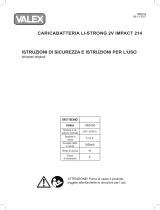 Valex 1060104 Manuale del proprietario
Valex 1060104 Manuale del proprietario
-
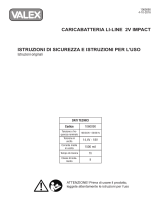 Valex 1060090 Manuale del proprietario
Valex 1060090 Manuale del proprietario
-
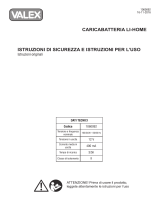 Valex 1060092 Manuale del proprietario
Valex 1060092 Manuale del proprietario
-
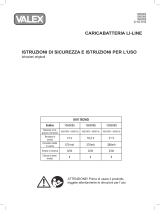 Valex 1060076 Manuale del proprietario
Valex 1060076 Manuale del proprietario
-
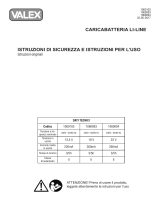 Valex 1060103 Manuale del proprietario
Valex 1060103 Manuale del proprietario
-
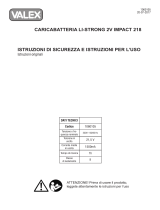 Valex 1060105 Manuale del proprietario
Valex 1060105 Manuale del proprietario
-
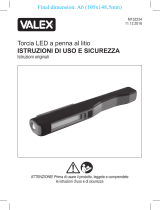 Valex 1152234 Manuale del proprietario
Valex 1152234 Manuale del proprietario
-
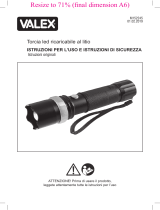 Valex 1152245 Manuale del proprietario
Valex 1152245 Manuale del proprietario
-
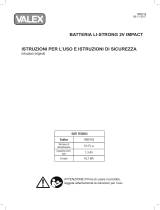 Valex 1060153 Manuale del proprietario
Valex 1060153 Manuale del proprietario
-
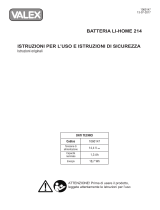 Valex 1060147 Manuale del proprietario
Valex 1060147 Manuale del proprietario
Altri documenti
-
GYS PORTABLE TRIPOD HAND LAMP (250L) Manuale del proprietario
-
GYS GYSPACK HERITAGE - 6/12V Manuale del proprietario
-
ProLights SMARTBATPLUS Manuale utente
-
GYS STARTPACK TRUCK MOBILE Manuale del proprietario
-
GYS STARTPACK TRUCK Manuale del proprietario
-
ProLights Portable cable free accent light Manuale utente
-
GYS GYSPACK PRO Manuale del proprietario
-
GYS GYSPACK AIR Manuale del proprietario
-
ProLights Portable cable free accent light Manuale utente





















